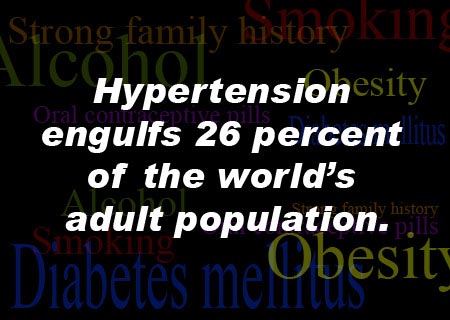Hypertension or elevated blood pressure is one of the most common lifestyle diseases affecting a very large number of people above the age of 50 years. It is one of the most easily detectable as well as correctable diseases of today’s era. Estimations claim that in 2000, approximately 26 percent of the entire world’s adult population suffered from hypertension. Blood pressure is measured conventionally by an instrument called the Sphygmomanometer and is recorded as a ratio of the systolic to diastolic. Systolic blood pressure is the higher of the two. It is a measure of the pressure exerted by the blood on the arteries during systole of heart .i.e. the time when heart is actively pumping the blood out to the rest of the body. Diastolic blood pressure is a measure of the pressure of blood on the arteries during the resting phase of the heart’s ventricles.
Optimum blood pressure is less than 120/80 mmHg, but it is a highly fluctuating value varying every minute and in every person. It is dependent on numerous factors and thus, whether a value has pathological significance or not can be determined by a range and never a single cut off value. Some of these factors are age, sex, activity, time of the day, condition of the arteries, volume of circulating blood, etc. Considered as the disease of the elderly and now the adults, incidence of hypertension is gradually rising among children and adolescents too due to poor lifestyle and dietary habits.
Risk factors for developing high blood pressure are strong family history, smoking, obesity, alcohol, oral contraceptive pills and diabetes mellitus. Hypertension is classified into two types based on the cause. Primary or Idiopathic or essential hypertension has no identifiable cause. Secondary hypertension may occur due to any one of the causes such as renal artery stenosis, chronic kidney disease, polycystic kidneys, glomerulonephritis, Cushing’s syndrome, phaeochromocytoma, Conn’s syndrome and hyperparathyroidism. Also acromegaly, hypothyroidism, co-arctation of the aorta, polyarteritis nodosa, steroids, Non-steroidal Anti-inflammatory Drugs (NSAIDs), oral contraceptive pills and pregnancy can trigger secondary hypertension.
Essential hypertension encompasses 95 percent of the cases of hypertension worldwide. And since no cause can be identified, treatment in these cases is purely aimed at palliating the symptoms caused by raised blood pressure. Symptoms are headaches, palpitations and signs of the underlying cause. Majority are asymptomatic with headaches being the commonest symptom. Eyes must be examined for retinopathy, kidneys for any disorder, any hormonal disturbances must be ruled out. Elevated blood pressure readings are the first findings.
Complications that can occur due to untreated or inadequately treated blood pressure are stroke, myocardial infarction (heart attack), kidney damage and retinopathy. Raised blood pressure affects multiple organs and leads to arteriolar thickening, constriction of retinal veins, retinal ischaemia, papilledema in the eyes in the long run. It causes concentric left ventricular hypertrophy, myocardial ischemia and may cause left ventricular failure as well as progressive renal failure.
Investigations include doing complete blood counts, serum electrolytes, serum creatinine, urine routine, urinary free cortisol, lipid profile, blood glucose, urinary dexamethasone, serum renin and aldosterone, abdominal and pelvis ultrasonography, chest x-ray, ECG, renal arteriography. Those with strong family history and risk factors must keep track of blood pressure and take adequate precautions to prevent them from developing.
The British Hypertension Society outlines the following grades of hypertension:
Normal blood pressure – <130/85 High normal – <130-139/ 85-89. No treatment. Reassess after 5 years.
Isolated Systolic Hypertension:
The grades are outlined so that there is standardization of initiation and continuation of treatment.
An entity called ‘White coat hypertension’ exists, where the blood pressure readings are high due to the stress of being with a doctor! On other occasions, they are found to be normal. ‘Pseudohypertension’ is another falsely elevated reading found generally in the elderly, due to hardened atherosclerotic arteries that don’t get easily compressed with the cuff. Both of these must be ruled out before initiating treatment. Thus the need for recording three readings on three different days before initiating therapy does arise. If all three are found to be raised, then therapy must be started.
Malignant hypertension is said to be diagnosed when consistent high blood pressure readings are found despite treatment and evidences of end-organ damage are seen. It can lead to death within months if not immediately controlled. Hypertension can also occur as an emergency and may need immediate hospitalization to bring it under control. This is called as Accelerated Hypertension. Sudden lowering may compromise tissue perfusion and thus it must be lowered gradually with controlled doses of medications.
Modern medicine has multiple drugs to bring blood pressure back to normal like Alpha-blockers, Beta blockers, Calcium channel blockers, Diuretics – the ‘ABCDs’ of anti-hypertensive therapy. There are ACE inhibitors and ARBs too. Associated diseases like diabetes must be treated, as controlling them helps in lowering blood pressure too. Aspirins can be seemingly given as an adjuvant to reduce cardiovascular risk. Statins can be given to reduce high triglycerides which indirectly reduce blood pressure too.
Auxiliary treatment involves restricting the amount of salt in diet to less than 5gm/ day total. Foodstuffs rich in salt like canned foods, preserved foods, etc should be avoided. Salt added in excess while cooking should be completely avoided. Smoking and alcohol must be stopped to prevent damage to other organs which in turn can elevate blood pressure. Stress levels must be curtailed as mental stress has been found to be a major cause of elevated blood pressure. Regular brisk walks should be taken to lose extra pounds as obesity is the leading risk factor for hypertension.
Alternative medicines such as Homeopathy and Ayurveda are also known to have benefits for high blood pressure, but consistency is doubtful. Yoga and meditation may help too. The idea is to relieve stress in all ways possible. Thus with dietary restrictions, adjuvant therapy, changes in lifestyle and habits, blood pressure can easily be tamed.
– Dr. Rachita Narsaria

